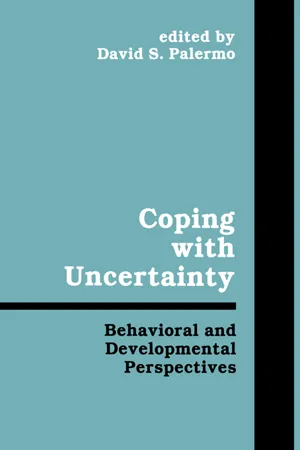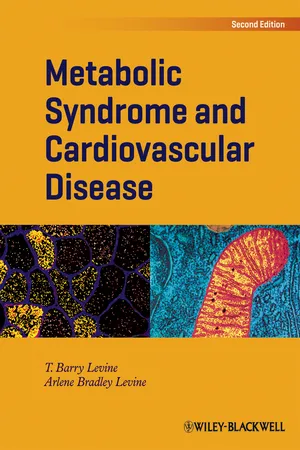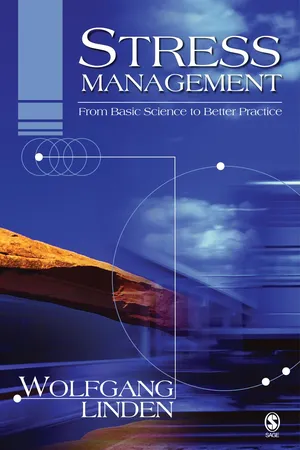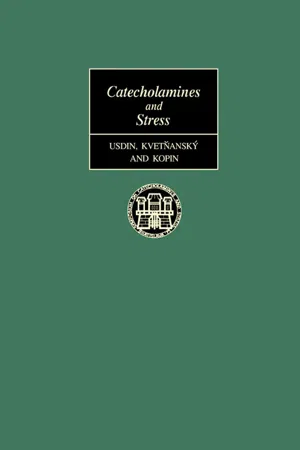Psychology
Sympathomedullary Pathway
The sympathomedullary pathway is a part of the body's stress response system, involving the activation of the sympathetic nervous system and the release of adrenaline from the adrenal medulla. This pathway helps prepare the body for "fight or flight" responses by increasing heart rate, dilating airways, and redirecting blood flow to muscles.
Written by Perlego with AI-assistance
Related key terms
Related key terms
1 of 4
Related key terms
1 of 3
8 Key excerpts on "Sympathomedullary Pathway"
- eBook - ePub
Coping With Uncertainty
Behavioral and Developmental Perspectives
- Davis S. Palermo(Author)
- 2014(Publication Date)
- Psychology Press(Publisher)
These physiological processes, evolved to defend the internal environment in the face of external challenge, endow the mammalian organism with a remarkable capability to resist internal disruption despite marked changes in the external environment. This chapter addresses the role played by the sympathoadrenal system in the maintenance of homeostasis. The functional state of the sympathetic nerves and adrenal medulla is directly dependent on regulatory centers within the brain. Input from the cerebral cortex and the limbic system serves to coordinate autonomic activity with cognitive processes and emotional reactions by influencing the activity of the regulatory brainstem centers that initiate sympathoadrenal outflow. These connections play an important physiological role, as described here, in that they prepare an organism to withstand a physiological challenge in anticipation of the acute event. Under certain circumstances, however, recruitment of a sympathoadrenal response may occur in response to perceived threat but in the absence of an appropriate physiological outlet; in situations such as these the resulting physiological changes may be detrimental. These concepts are clarified in this chapter with specific examples. Before proceeding, however, it is necessary to consider the organization of the sympathoadrenal system and methods of assessing sympathoadrenal activity. ORGANIZATION OF THE SYMPATHOADRENAL SYSTEM The sympathetic nervous system and the adrenal medulla form an integrated functional unit referred to as the sympathoadrenal system. Catecholamine release at sympathetic nerve endings and from the adrenal medulla is the direct result of a descending flow of impulse traffic originating in regulatory centers in the hypothalamus, pons, and medulla oblongata. Bulbospinal tracts from these regulatory centers descend in the spinal cord and synapse with typical preganglionic cholinergic neurons in the intermediolateral cell column of the spinal cord - eBook - ePub
Stress at Work
A Sociological Perspective
- Chris Peterson(Author)
- 2018(Publication Date)
- Routledge(Publisher)
40 ) also have reported a relationship between emotion and physiological response, in that men who prefer problem-oriented coping over emotional coping have higher plasma catecholamine and testosterone levels. Also, these authors argue that a loss of control brings into play the parasympathetic nervous system.By the early 1970s Mason had concluded that we could now say that adrenocortical activity reflected subtle psychological stimuli. Cannon’s (20 ) work also showed that the sympathetic-adrenal medullary system was influenced by psychological factors. Selye had observed that psychological stimuli can elicit a substantial pituitary-adrenocortical response, although he did not emphasize this in his discussions of the overall stress response.There are some reasons why physiological and psychological approaches have remained distinct. First, research into the stress response has not been very interdisciplinary, even though our understanding of the response involves knowledge derived from many different approaches. Second, stress research arose from two quite different physiological bases. One focused on the action of the sympathetic nervous system, which in its measurement is less responsive to the impact of emotional and cognitive factors. The other focused on the workings of the hormonal system through the adrenal medulla. This latter stream of research took much longer to capture the imagination and interests of researchers. The hormonal system is more responsive to measures of emotional response.Research has now shown a strong interrelationship between emotional factors and the physiological response. This is largely due to advances in technologies that can measure the hormonal effects of emotional and cognitive responses. Mason argues that “the question of how the many hormones in the body act together as a group to accomplish the homeostatic regulation of physiological processes is one of the major unsolved problems in endocrine physiology” (48 - eBook - ePub
Environmental Illness
Myth & Reality
- Herman Staudenmayer(Author)
- 2018(Publication Date)
- Routledge(Publisher)
The use of such a sensitive measure which reacts to placebo factors of suggestion, anticipation, and expectation cannot be validly interpreted unless double-blind testing has been achieved. Provocation challenges conducted by the clinical ecologists were found to lack true double-blind conditions (McCourtie, 1990). Independent replication of the claimed effects must be established scientifically before the validity of pupillary measurements is accepted.Autonomic nervous systemThe third physiological system involved in the stress-response is the autonomic nervous system. There are numerous biological markers of the stress-response that can be measured in several physiologic pathways mediated by the autonomic nervous system, including neuromuscular, cardiovascular, neurohumoral, and interneuronal (Straight and Vogt, 1997). The hypothalamic CRH systems form a feedback loop with the LC-NE systems, and this loop affects the ANS (Aston-Jones et al., 1991). NE can profoundly affect numerous types of endocrine and autonomic regulation, including cardiovascular function and respiration. This has been well established in animal studies in which NE is applied to brain sites that are the targets of these NE cells (Guyenet, 1991). Similar effects can occur in humans through endogenous pathways of the stress-response. Mayberg (1992) cautioned that these effects must be taken into account when evaluating symptom report or brain-imaging studies in forensic situations involving EI patients. With respect to clinical psychiatry, many isolated but seemingly attractive brain-imaging findings, employing a wide variety of methodologies, have resulted in speculative musings, rather than the construction of a significant, testable hypothesis and validation with an independent sample (Brodie, 1996).The descending pathways of the ANS have two branches, the sympathetic and parasympathetic. The sympathetic nerves originate from neurons located in the intermediolateral column of the spinal cord; the parasympathetic nerves are axons of cells located in the dorsal motor nucleus of the vagus in the medulla (LeDoux, 1987). The sympathetic postganglionic endings primarily secrete NE; the parasympathetic postganglionic endings secrete acetylcholine (Ach). NE and Ach mediate the effects on the end organs innervated by the ANS and are referred to as sympathetic (adrenergic) or parasympathetic (cholinergic) mediators. In general, adrenergic mediators facilitate responses associated with arousal, and cholinergic mediators facilitate responses associated with inhibition and relaxation. The effects of these transmitters are not always direct because they may modulate other transmitters and have interactive effects. For example, an inhibitory effect of Ach on another system may cause an arousal response in an end organ. - eBook - ePub
- T. Barry Levine, Arlene Bradley Levine(Authors)
- 2012(Publication Date)
- Wiley-Blackwell(Publisher)
2 the noradrenergic neurons of the locus ceruleus / norepinephrine nuclei of the brainstem. These neurons stimulate the sympatho-adrenal system.In effect, the CRH-hypothalamic and the noradrenergic-brainstem pathways propagate stress pathways by engaging the autonomic nervous system and the endocrine distress reaction [3, 5].These responses are further amplified as hypothalamic and brainstem pathways innervate and stimulate each other [3, 5]. Thus CRH activates not only the HPA axis but also the sympatho-adrenal system: CRH increases norepinephrine synthesis by enhancing tyrosine hydrolase activity, and it increases both the firing rate of, and the norepinephrine release from, the locus ceruleus [1].These hypothalamic and the brainstem loci also stimulate.- the mesocorticolimbic dopaminergic system to mediate anticipatory and award phenomena and
- the amygdala, impacting arousal, mood, memory, and attention during the acute response to stress.
Peripheral stress pathways
Central perception of a stressor elicits the peripheral physiologic distress responses via seemingly instantaneous neuronal, and more delayed, but sustained, endocrine responses:- within the autonomic nervous system, there is withdrawal of parasympathetic vagal tone and sympathetic activation;
- from an endocrine perspective, there is activation of the HPA axis and of the sympatho-adrenals with involvement of the gonads;
- these, in turn, activate the renin–angiotensin–aldosterone system (RAAS) and endothelin effects;
- lastly, there is induction of proinflammatory as well as pro-oxidant signaling.
From an evolutionary perspective, the acute peripheral distress response to sudden environmental threats benefits survival . It entails improved physical, sensory, and cognitive performance. The Olympic motto “citius, altius, fortius” can describe the actions of some such stressed individuals. Superior physical prowess is matched by enhanced sensory perception, mental alertness, and memory [6].The distress response also provides the underpinnings for such superior performance. It establishes the underlying hyperdynamic cardiovascular and immune state to implement an effective fight or flight strategy [1]. It also aims to secure ready fuel availability for this endeavor by increasing insulin resistance in nonessential tissues and by interrupting dispensable functions, such as growth [1, 6]. - eBook - ePub
- John A. Russell, Michael J. Shipston, John A. Russell, Michael J. Shipston(Authors)
- 2015(Publication Date)
- Wiley-Blackwell(Publisher)
Chapter 5 Stress and Sympathoadrenomedullary MechanismsRegina Nostramo and Esther L. SabbanDepartment of Biochemistry and Molecular Biology, New York Medical College, Valhalla, New York, USAWidespread effects of stress on the expression of numerous components of adrenomedullary chromaffin cells. In response to stress, the adrenal medulla receives increased splanchnic nerve input via activation of the sympathoadrenal axis as well as increased exposure to glucocorticoids (CORT) via activation of the hypothalamic–pituitary–adrenocortical (HPA) axis. These and other pathways mediate numerous changes in chromaffin cells (an adrenergic chromaffin cell is pictured: end products of noradrenergic chromaffin cells are indicated in italics). This includes altered expression of catecholamine biosynthetic enzymes, peptides (i.e. enkephalins, neuropeptide Y, urocortin 2, corticotropin-releasing hormone), vesicle-related proteins (i.e. VMAT2, Cgs) and receptors (i.e. AT2 R, B2R). Chromaffin cell–cell communication is also enhanced by increased gap junction formation. Overall, these effects of stress lead to increased catecholaminergic biosynthetic capacity, vesicular storage, chromaffin cell–cell coupling and quantal catecholamine release. ACh, acetylcholine; AT1 R and AT2 R, angiotensin II type 1 and type 2 receptors; B2R, bradykinin B2 receptor; CORT, corticosterone or cortisol; Cgs, chromogranins; DBH, dopamine beta-hydroxylase; Epi, epinephrine; GTPCH, GTP cyclohydrolase; NE, norepinephrine; PACAP, pituitary adenylate cyclase-activating polypeptide; PNMT, phenylethanolamine N-methyltransferase; TH, tyrosine hydroxylase; VMAT2, vesicular monoamine transporter 2.5.1 Stress and research on stress
5.1.1 Definition of stress
While an individual readily recognizes ‘stress’ when it is experienced, it is not always easy to define. Modern stress theories view stress as a sensed threat to homeostasis - eBook - ePub
Stress Management
From Basic Science to Better Practice
- Wolfgang Linden(Author)
- 2004(Publication Date)
- SAGE Publications, Inc(Publisher)
Chapter 2 ). Instead, the physiological activation process is described first because it is central to the originality of Selye's work. Selye believed in response universality; that is, all stimuli above perception threshold are held to trigger similar physiological stress responses across different species and across situations. This presumably universal cascade of events (adapted from Sarafino, 2002) is as follows:- Environmental stimuli that are judged to be of subjective importance trigger cortical activation that sends chemical messengers to the hypothalamus, where
- they stimulate the production of corticotrophic releasing factor (CRF) and other chemical messengers that, in turn, activate two distinct tracks of bodily reactions.
- In the first track (also commonly referred to as the sympathetic adrenal medullary axis), these messengers feed information forward to the pituitary gland, which
- changes the chemical structure of the messengers and releases adrenocorticotropic hormone (ACTH) into the bloodstream.
- When ACTH reaches the adrenal glands, it initiates the production of cortisol, which, in turn, increases metabolic rate. Cortisol inhibits the function of phagocytes and lymphocytes in the immune system (i.e., it serves as a messenger for needed adaptations of the immune system).
- On the second track (commonly referred to as the hypothalamic-pituitary axis), chemical messengers leave the hypothalamus and trigger electrochemical changes that advance as signals down the brain stem and the spinal cord toward the adrenal glands.
- At the level of the adrenal gland, this activation leads to release of epinephrine, which supplies extra glucose to musculature and brain. Epinephrine also increases suppressor T-cells and decreases helper T-cells, thus revealing a second connective pathway of stress reactivity to immune function.
- eBook - ePub
Catecholamines and Stress
Proceedings of the International Symposium on Catecholamines and Stress, Held in Bratislava, Czechoslovakia, July 27–30, 1975
- Earl Usdin, Richard Kvetnanský, Irwin J. Kopin(Authors)
- 2014(Publication Date)
- Pergamon(Publisher)
Dr. Henry replied that this was not possible since in the particular design of population cage used for the studies, food and water were provided in every box, so the dominant could not deny access to it to the others. He felt that the question raises a very important point concerning the definition of stress. The work of John W. Mason has demonstrated that it is the psychological reactions that accompany the classic physical stress situation that are causing the endocrine response. For example, he has described an experiment in which monkeys were fasted but were provided with bulk intake by substutution of a heavily fruit-flavored pellet diet; they showed a different hormonal response from those fasted by conventional complete withdrawl of food. Dr. Mason surmised that the difference was due to the fact that the familiar animal caretaker repeatedly passed the hungry animal without providing food-a powerful phychological stimulus. In recent discussions of “Confusion and Controversy in the Stress Field,” Mason comments that the unrecognized, first mediator in much stress experimentation may simply be the arousal of the emotions by the noxious, unpleasant, novel or arousing conditions to which the animal is exposed. Work at the Instititute of Experimental Endocrinology in Bratislava by Dr. L. Mikulaj’s group has established that with repetition there is a decrease in the intensity of the adrenal-cortical response to the same stimulus. This is evidence they are dealing with a changing psychosocial evaluation by the animal. Thus the sensitivity of the neuroendocrine mechanisms has adapted in response to a change in the perceived significance of the stimulus. Dr. Kvetnansky’s group, has established that repetition of the same stimulus as that used by Mikulaj’s group will induce a significant increase of adrenal-medullary catecholamine biosynthesis. This change in response pattern implies that the animal’s changing perceptions have induced a shift from an effect appropriate for the pituitary-adrenocortical mode towards the sympathetic adrenal-medullary mode. This implies arousal of the defense rather than the conservation-withdrawl response.With regard to seeking a definition of stress, Dr. Henry proposed to specify the psychosocial stress on the organism when the experience leads to a combined neurohumoral and affective arousal. This arousal is of inappropriate intensity and duration or both for the normal physiological processes of reproduction and metabolism, and if it persists it will lead to strain involving pathophysiological changes. At the neuroendocirine level, either the Cannon sympathetic adrenal-medullary response or the Selyean pituitary adrenal-cortical response is involved, or both. Depending on the previous experience of the animal and the nature of the stimulus, the response is associated at the affective level with arousal of the fight-flight defense reaction or with a depressive subordinate playing-dead emotional response or a mixture of the two.Dr. Weinshilboum - eBook - ePub
- E.A. Mayer, C.B. Saper(Authors)
- 2000(Publication Date)
- Elsevier Science(Publisher)
III. The neurobiology of the stress response Chapter 3 Protective and damaging effects of stress mediators: central role of the brain Bruce S. McEwen *, Harold and Margaret Milliken Hatch Laboratory of Neuroendocrinology, The Rockefeller University, 1230 York Avenue, New York, NY 10021, USA * Corresponding author. Tel.: 212-327-8624; Fax: 212-327-8634 Introduction When the body is challenged physically or psychologically, the physiological responses of the autonomic nervous system and neuroendocrine system promote adaptation and survival in the short run. However, the same physiological response systems can cause damage and exacerbate disease processes over longer periods of time. The relationship between these paradoxical aspects of stress hormone action has been with us since the late Hans Selye introduced the stress concept in 1936 (Selye, 1936). Understanding the basis for the paradoxical role of stress hormones is closely tied to the further elaboration of two aspects of mind-body interactions (see Fig. 1); first, are the ways in which genetics, developmental processes and experience influence how the brain processes events and responds to them as potential stressors, and second, the nature of the behavioral and physiological responses to the stressful challenge, particularly the ways in which these responses may protect the body or contribute to pathophysiological changes. In the case of behavior, the concern is whether the response gets the individual out of trouble or if it further exacerbates the situation and contributes to the eventual wear and tear on the body. In the case of physiological responses, the key point is how efficiently these responses are turned on and then turned off again when no longer needed. This paper summarizes a new formulation of this relationship and illustrates it with examples from the cardiovascular/metabolic and immune systems and the brain
Index pages curate the most relevant extracts from our library of academic textbooks. They’ve been created using an in-house natural language model (NLM), each adding context and meaning to key research topics.
Explore more topic indexes
Explore more topic indexes
1 of 6
Explore more topic indexes
1 of 4







